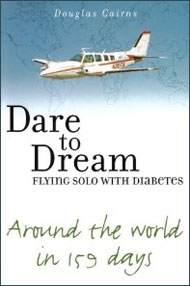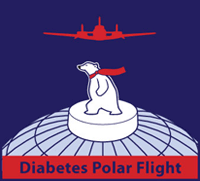

NEWS:
Discovery TV's "Flying Wild Alaska" – Diabetes Polar Flight On Friday 16 December, (and Sat 17, & Sun 18) Discovery TV is set to feature Diabetes Polar Flight under the title "Top of the World"
Diabetes Polar Flight Reaches The Top Of The World!
- Flight Summary 21st April 2011
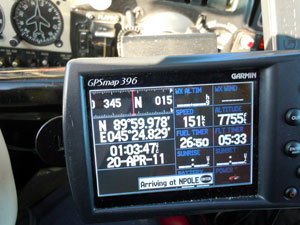
What
a terrific project! Weather on Alaska’s North Slope can be appalling but early 19th April
saw clear and sunny skies that stretched all the 1130 miles to the North Pole,
with the exception of 100 miles of low cloud. It took 8 hours and 20 minutes
to reach the Geographic North Pole, battling 25 knot headwinds at "optimum
cruise" (for efficient speed and fuel consumption) and temperatures
at 7,500 feet hovered around minus 18 degrees centigrade the entire journey.
Each hour I switched fuel tanks to manage flows from the extra fuel tanks carrying
250 gallons of fuel. Another hourly "cockpit check" was
blood sugar testing, and with additional continuous glucose monitoring, I was
delighted to see blood sugars remaining in a tight and good range for flying.
Six hours after take off and passing over continuous ice cover, I passed over the estimated position of Magnetic North Pole. Almost two hours later at 01:03:47 Hours Zulu (Greenwich Mean Time) on 20th April, the Baron crossed the Geographic North Pole.
At this time I was lapping up the atmosphere and circled around the Pole, a maneuver that passes through 24 time zones within a couple of minutes. It was quite surreal, and extremely exhilarating, flying where the sun shines 24 hours a day, right at the crown of our planet earth. Very shortly after two of my three GPS systems failed - they cannot cope with proximity to the Pole - and with one GPS only reading my own position, I weaved my way down the E 134 39 line of longitude, with the sun at an angle to my left, and found Barneo Ice Camp, a Russian ice base, 30 miles to the south.
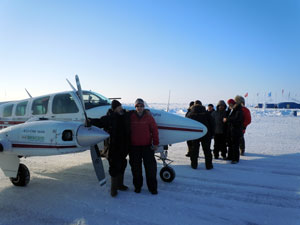
What an amazing place to land! The 900 meter (bulldozed) ice strip was bumpy
but I slowed up in good time and after shutting the engines down, it was
a truly exhilarating moment to be standing on the polar ice. I can only
say good things about Russian hospitality - it was the equivalent of 4.30
a.m. for the ice camp but 20 people were out to watch the Baron land in minus
26°C, and after photos I was taken to a warm tent and fed with
a hearty soup and sandwiches, which after 8.5 hours flying time, were most
welcome.
The landing can be viewed at the following link.
On climbing back into the Baron, I had the nastiest scare of the whole mission when the pilot door absolutely refused to close. Part of the locking mechanism had likely contracted in the intense cold, and I had nightmarish visions of abandoning the Baron on the ice, but thankfully some engineering lubricant and brute force (helping push the door closed from the outside) saved the day after 40 minutes of quite frantic work.
The return journey to Barrow took just 6 hours and 20 minutes with strong tailwinds at around 8,000 feet. The first hour though, I stayed low, around 50 feet above the ice, lapping up the amazing landscape (icescape).
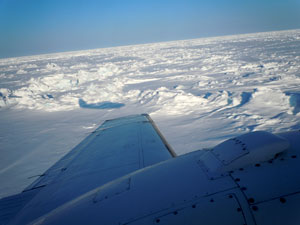
Overall Diabetes Polar Flight has been an amazing experience. By carrying out such an endurance-related flight and landing at the Pole, we very much want to convey the message that diabetes need not limit the scope of people’s dreams and ambitions.
I have many thanks to give, firstly to the support team, Ron Sheardown, who has given invaluable advice and training preparations, and Karl Beetson for all the technology and communication management - Ron, Karl, and Sophie took two-hourly satellite telephone position reports in Barrow, and it was always a very welcome two-hourly check in while en-route.
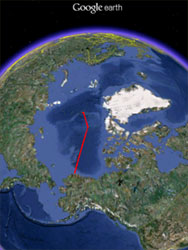
Also thanks to Ditto for extremely thorough aircraft preparations in Anchorage, to Era Alaska for their support in Barrow, Rob Stapleton for the same out of Anchorage, and to our corporate supporters, Threadneedle Asset Management, Dexcom Inc., the continuous glucose sensor company, and Roche Diagnostics/Accu-Chek Mobile blood glucose testing company.
Also thanks to Barneo Ice Camp for making the polar landing possible, and for the great hospitality. By amazing coincidence, a Discovery Channel docmentary crew was in Barrow to film Era Alaska's aviation activities for "Flying Wild Alaska" and the team spent time with us to cover our polar mission - many thanks to Roger and the team for their interest in our project.
Thank you also everyone who has made donations to the Juvenile Diabetes Research Foundation (www.jdrf.org.uk) which aims to find a cure for type 1 diabetes. There are many, many more to thank, many of whom are on our Supporters page. The fund raising goes on, and many thanks also go to Mel and Deb Parker and Alan Rogers for organizing our fund-raising dinner on 10th June at The Grange Hotel at St. Pauls, London.
About Diabetes Polar Flight
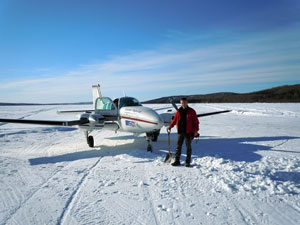
Diabetes Polar Flight (DPF) was originally planned to overfly the North Pole from Resolute, Canada, with a safety pilot. However, working with Ron Sheardown who helped immensely with preparations and support in Alaska, the idea developed into a solo flight from Barrow, Alaska plus a landing at the North Pole, with ice-landing training on a frozen lake 200 miles north of Anchorage in March (see photo on RHS). The project was a great success with over £23,000 ($36,000) funds raised for the Juvenile Diabetes Research Foundation. Douglas now carries out charity flights around the USA for JDRF and is breaking and setting records in the UK in a Vans RV8 (www.flyingwithdiabetes.com). Another polar flight is planned for winter 2013/2014.
National Aeronautic Association Award Ceremony – 15 March 2011
Douglas was delighted to receive an award in Washington DC for last year’s Diabetes Flight 50 being recognized by the National Aeronautic Association as one of the Most Memorable Aviation Records of 2010.
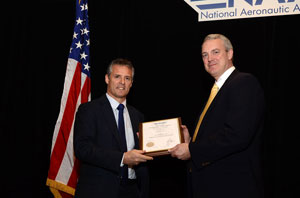
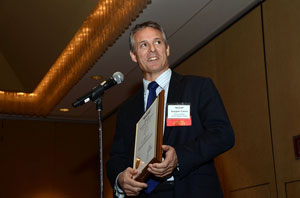
Fund-Raising Dinners
Fund-Raising for Juvenile Diabetes Research Foundation (www.jdrf.org.uk)
The past three years of diabetes flying projects and fund-raising dinners have raised over £57,000 for the Juvenile Diabetes Research Foundation (JDRF), the world's largest supporter of research into finding a cure for type 1 diabetes.
On June 10th an annual fund-raising dinner was held, a joint effort at The Grange Hotel, to raise funds for both the Juvenile Diabetes research Foundation (JDRF) and Indian Ocean Disaster Relief which focuses on helping vulnerable children. Over £23,000 was raised by both the dinner and direct donations for Diabetes Polar Flight for JDRF in 2011, and a huge thank you goes to Melanie and Deborah Parker and Al Rogers for all their dinner organizing over the last three summers.
While JDRF aims to find a cure for type 1 diabetes, up to 85% of the JDRF-supported research projects can also benefit diabetes management for people with type 2 diabetes. While diabetes is a controllable medical condition, it can also be an insidious disease with long-term complications if not diagnosed early or if good overall control cannot be achieved – we are passionate about supporting JDRF in its quest to find a cure and also help improve diabetes control.
